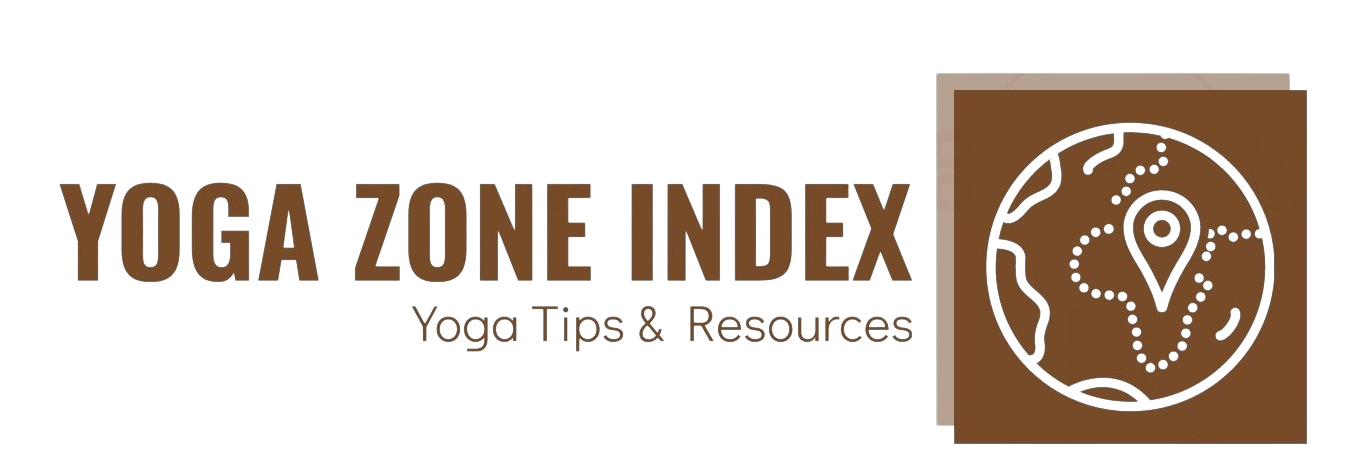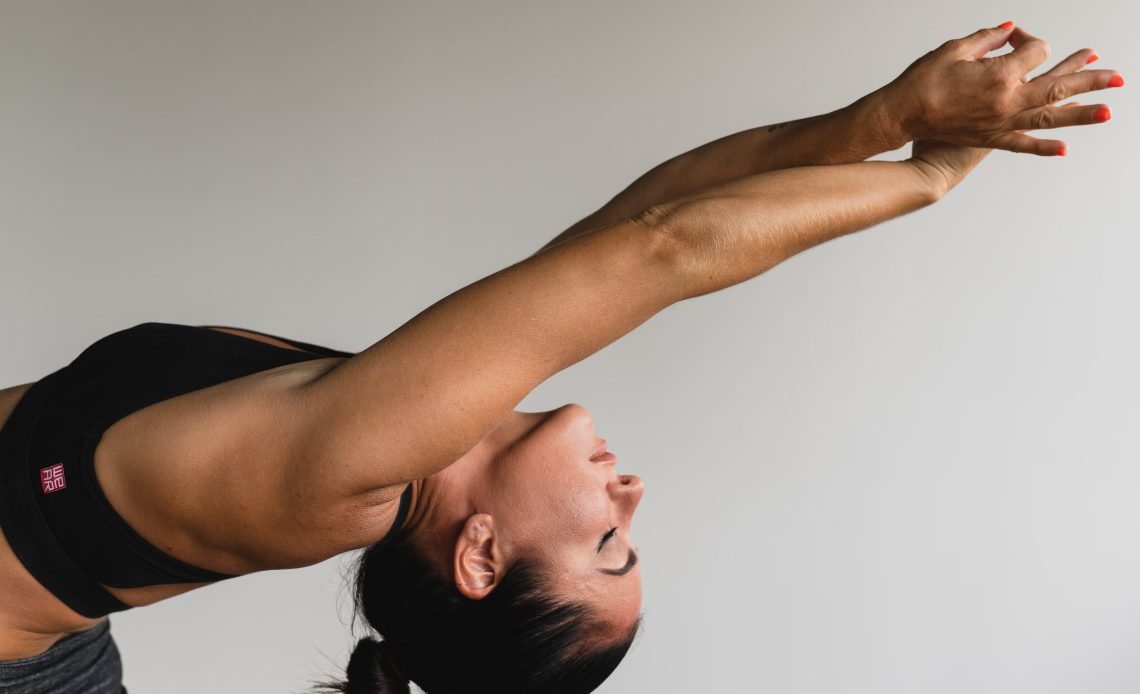
The practice of yoga is widely recognized for its potential in fostering physical well-being, mental tranquility, and spiritual harmony. One area where yoga has exhibited profound efficacy is in managing and mitigating the symptoms of sciatica, a condition characterized by nerve pain extending from the lower back to the legs. This article provides a comprehensive guide on how yoga can offer relief from sciatic pain and enhance overall health.
Understanding Sciatica
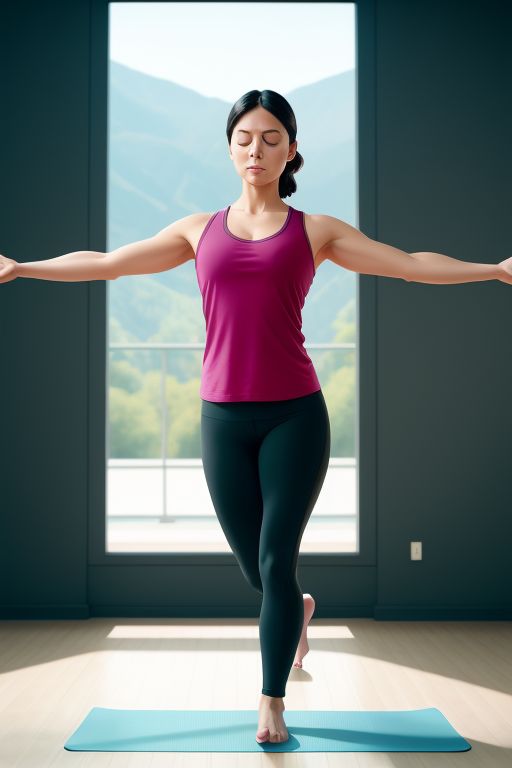
Regarded as the largest nerve in the human body, the sciatic nerve originates in the lumbar region of the spine, traverses through the buttocks, and continues down the legs’ side. Irritation, compression, or injury to the sciatic nerve or the lower vertebrae can lead to a condition known as sciatica. In some instances, overly tight, overused, or injured muscles might also instigate sciatica.
Sciatica manifests as a sharp, throbbing, or burning sensation that either radiates down the leg or shoots through it. Accompanying symptoms may include numbness, tingling, and inflammation, often localized to one side of the body. In some individuals, sciatica might be a minor discomfort, while in others, it can escalate to severe, debilitating pain.
The Yoga-Sciatica Connection
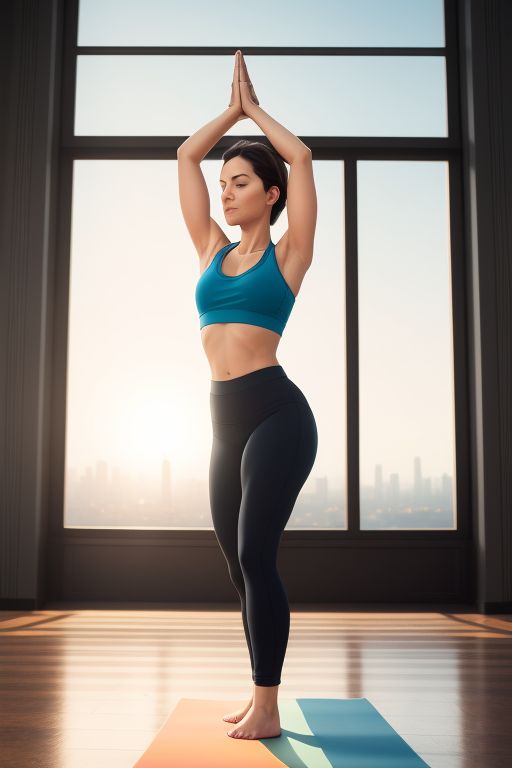
Practicing yoga for sciatica has been found to alleviate the associated symptoms and prevent nerve pain. Specific yoga asanas, when combined with slow, conscious breathing, can provide immense relief to individuals with back pain and those suffering from sciatica. It enables them to manage their pain effectively and avert potential complications.
Although yoga is not a substitute for physical therapy or medical advice, applying specific asanas correctly, considering an individual’s medical diagnosis, can contribute positively to managing sciatica. Yoga can help enhance spinal health, improve posture, and balance, essential factors in preventing and treating sciatica.
Common Causes and Symptoms of Sciatica
The onset of sciatica can be attributed to various factors including:
- Disc Herniation: A condition where the lumbar discs (disc-like structures in the lower spine) get herniated due to stress, trauma, or disease. This is the most common cause of sciatica, accounting for approximately 85% of cases.
- Spinal Stenosis: This condition, which usually occurs in the neck and lower back, involves the narrowing of the spinal canal. This places pressure on the spinal cord and other spinal nerve roots branching out from the vertebrae, leading to back pain and sciatica.
- Spondylolisthesis: This condition occurs when one vertebra slips over the vertebra below it, potentially pinching the nerves in the spine and leading to sciatic pain.
- Degenerative Disc Disease: As we age, the spinal discs located between the vertebrae gradually wear out, making them more prone to herniation. This often becomes another significant cause of sciatica.
- Obesity, Accident, and Injury: These factors can directly affect the sciatic nerve, leading to sciatica.
- Piriformis Syndrome: This condition involves spasms of the small muscles below the larger muscles of the buttocks, known as the piriformis muscle. Spasms of the piriformis muscle can irritate or compress the sciatic nerve, often causing lower back pain that is difficult to diagnose.
The most common symptoms of sciatic nerve pain include pain, weakness, and numbness or a tingling sensation. The pain may either be constant or occur irregularly, like a spasm. People with sciatica often experience:
- Pain in the lower back region
- A heavy feeling in the legs
- A constant, dull pain in the hips, back, and buttocks
- Burning or tingling sensation in the legs, toes, and feet
- Pain that worsens when moving or changing posture
- Numbness or weakness in the legs and feet
In extreme cases, individuals may experience a loss of movement in the affected region. In rare instances, sciatica may lead to a condition known as ‘cauda equina syndrome,’ characterized by an inability to control the bladder or bowels.
Yoga Poses for Sciatica Relief and Prevention
Below, we delve into nine yoga poses that can help release tension in the muscles causing sciatica pain. These poses can also help to re-balance and strengthen the relevant muscle groups in the body. It is essential to incorporate these postures into a balanced practice. If you feel that a particular posture or exercise increases your pain during or after the practice, inform your yoga instructor.
1. Child’s Pose (Balasana)

Child’s Pose is a simple, yet effective, way to stretch your spine, promoting flexibility and openness in your hips, thighs, and lower back.
- Begin in a tabletop position, with your hands and knees on the floor.
- Bring your knees together and sink your hips back onto your heels.
- Extend your arms in front of you or allow them to rest alongside your body.
- Allow your torso to relax completely as you fall heavy into your thighs.
- Focus on deepening your breath to relax any areas of tightness or sensation.
- Hold this pose for up to 5 minutes.
For additional support, consider placing a cushion or bolster under your thighs, chest, and forehead.
2. Downward-Facing Dog
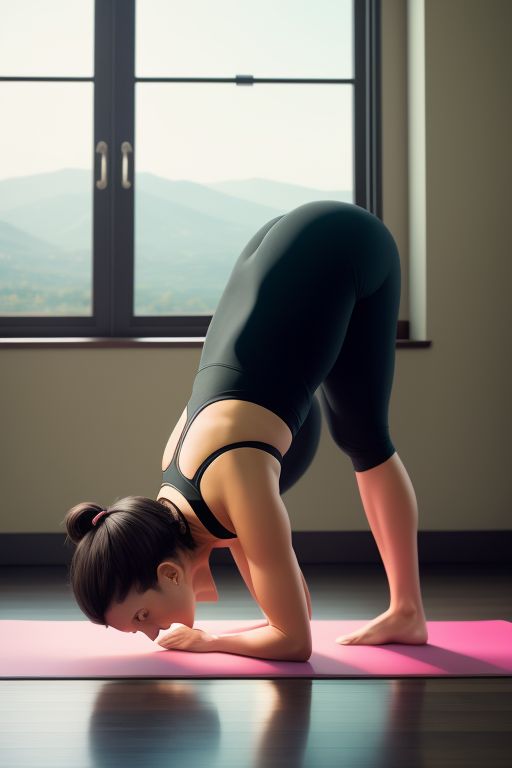
Downward-Facing Dog is an excellent pose that brings your body into alignment, relieving pain and tightness. It also promotes strength in your entire body, helping to correct imbalances.
- Start on your hands and knees. Press into your hands as you lift your hips toward the ceiling.
- Drop your head down to bring your ears in line with your upper arms or your chin all the way in toward your chest.
- Bend your knees to tilt your pelvis slightly forward.
- Intuitively move your body through any variations that feel appropriate.
- Hold this pose for up to 1 minute.
3. Half Moon Pose (Ardha Chandrasana)
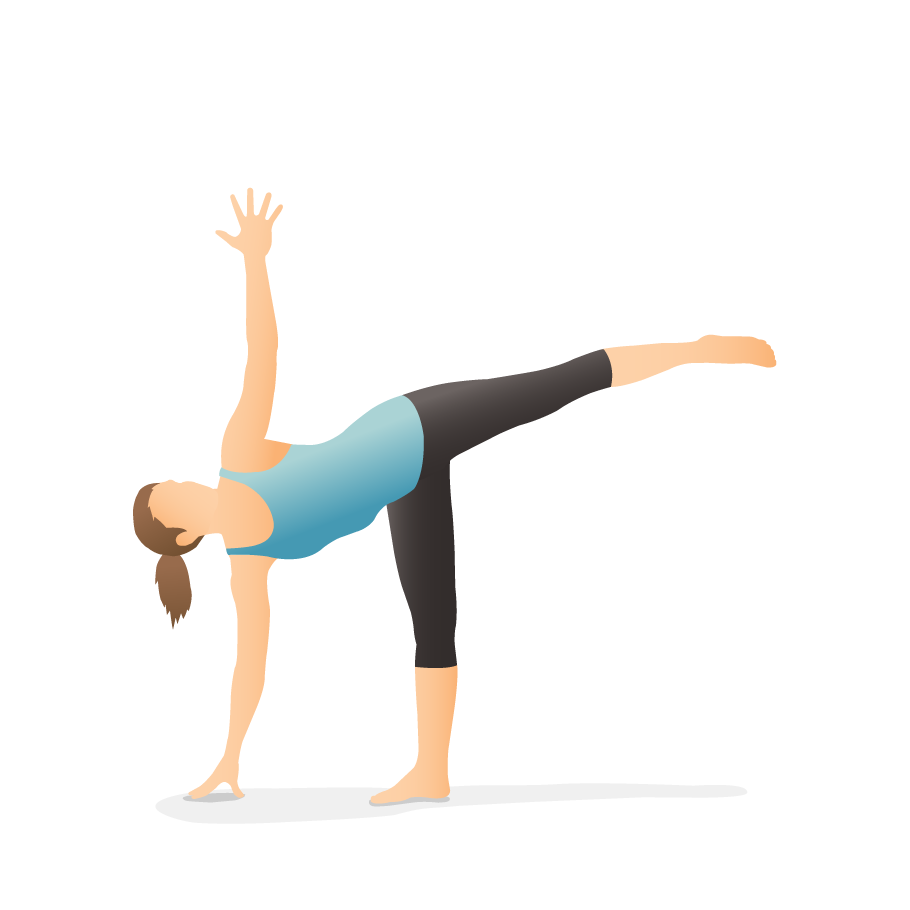
Half Moon Pose is a balancing pose that strengthens, stabilizes, and increases flexibility in your body. It relieves tension and stretches your spine, glutes, and thighs.
- Start in a standing pose, such as Triangle, with your right foot in front.
- Bend your right knee a bit deeper and yield your weight into your right foot.
- Bring your left hand to your hip.
- Slide your left foot forward a few inches as you reach your right hand to the floor in front of and to the right of your right foot.
- Lift your left leg so it’s parallel to the floor, pressing out through your left heel.
- Rotate your torso and hip open as you gaze forward.
- To go deeper, lift your left hand up toward the ceiling and turn your gaze upward.
- Hold this pose for up to 1 minute.
- Slowly release by bending your right leg and lowering your left leg to the floor, returning to the starting position.
- Repeat on the opposite side.
Stay supported by doing this pose against a wall. You can place a block under your hand if needed.
4. Cobra Pose (Bhujangasana)
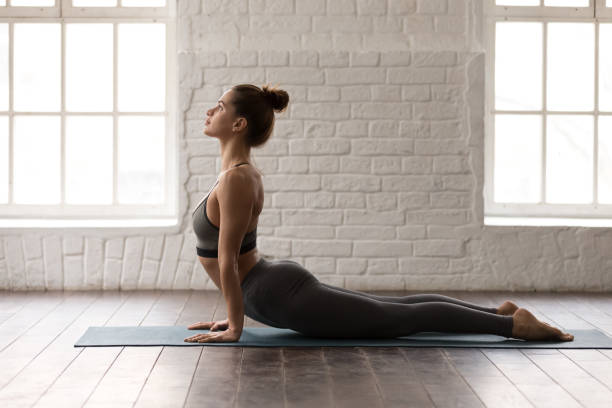
The Cobra pose is a soothing yoga pose that strengthens and stretches your spine, promoting circulation and flexibility.
- Lie on your stomach with your hands under your shoulders.
- Squeeze your elbows into your body.
- Inhale to lift your head, chest, and shoulders.
- Maintain a slight bend in your elbows and keep your chest open.
- Engage your thighs, lower back, and abdominals.
- Hold for up to 30 seconds.
- Release the pose, rest, and repeat 1-3 times.
5. Locust Pose (Salabhasana)
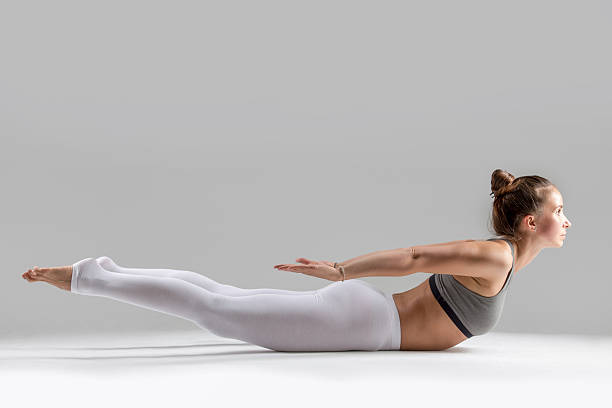
The Locust Pose strengthens your spine, glutes, and thighs. It stabilizes your core and lower back and also promotes circulation and flexibility in your hips.
- Lie on your stomach with your fingers interlaced at the base of your spine.
- Slowly lift your chest, head, and arms up as high as you can.
- Bring your arms up and away from your body.
- To go deeper, raise both of your legs or 1 leg at a time.
- Engage your glutes, lower back, and abdominals.
- Hold for up to 30 seconds.
- Release the pose and return to the starting position.
- Rest and relax your body for a few breaths while gently moving your hips from side to side.
- Repeat 1-2 times.
6. Knees-to-Chest Pose/Wind-Relieving Pose (Pawanmuktasana)
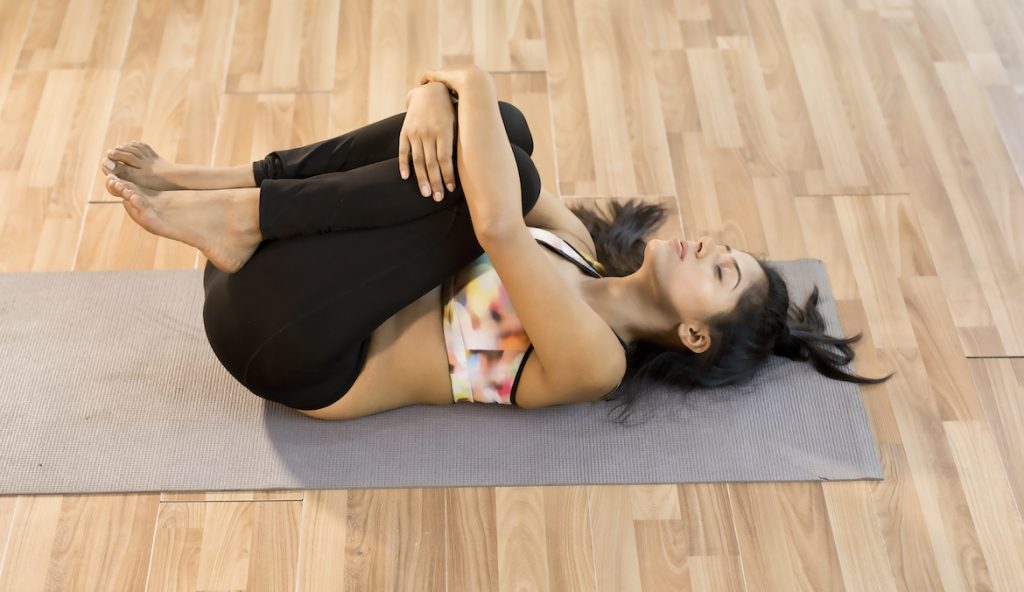
This pose is excellent for relieving tightness in your lower back, hips, and glutes.
- Lie on your back and draw both knees in toward your chest.
- Draw your ankles and knees together as you reach your hands around the backs of your thighs or around your shins.
- If your hands reach, interlace your fingers or take hold of opposite elbows.
- To deepen the stretch, lift your head and tuck your chin into your chest.
- Hold this pose for up to 1 minute.
To feel the pose less intensely, do one leg at a time.
7. Reclined Pigeon Pose (Supta Kapotasana)
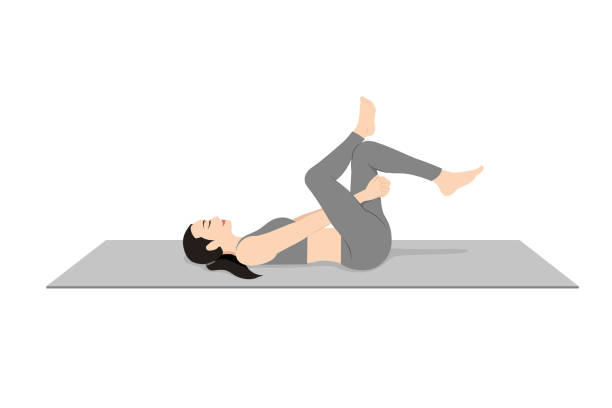
Doing the Pigeon Pose on your back helps support your lower back and puts less pressure on your hips. The Reclined Pigeon Pose stretches your glutes and hips as well as the piriformis muscle.
- Lie on your back with your knees bent and your heels in toward your hips.
- Bend your right knee and bring your right ankle to the bottom of your left thigh.
- Stay here if you already feel a deep stretch.
- To go deeper, lift your left foot and draw your left knee in toward your chest.
- Interlace your fingers to hold behind your left thigh or shin.
- Hold for up to 1 minute.
- Repeat on the opposite side.
8. Bridge Pose (Setu Bandha Sarvangasana)
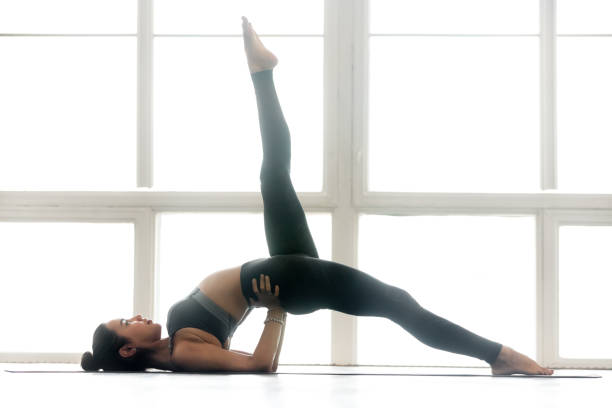
The Bridge Pose stretches the spine, relieving pain and tension. Its gently stimulating effect on the body boosts circulation. Plus, it works your legs, glutes, and core.
- Lie on your back with your knees bent and your heels in toward your hips.
- Place your hands down by your sides with your palms facing down.
- As you inhale, lift your hips up toward the ceiling.
- Hold this pose for up to 1 minute.
- As you exhale, slowly lower your hips back to the ground.
9. Half Lord of the Fishes Pose (Ardha Matsyendrasana)
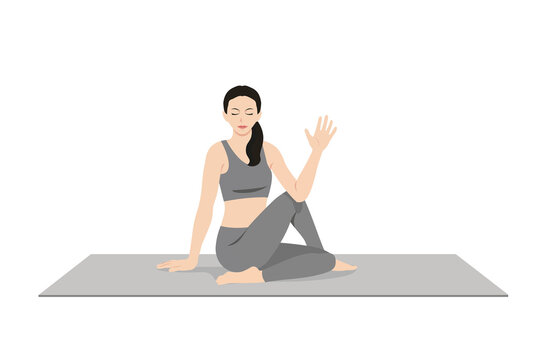
- Sit on the ground. Bend your knees, placing your feet on the floor.
- Slide your left foot under your right leg to the outside of your right hip. Lay the outside of the left leg on the floor. Step the right foot over the left leg and stand it on the floor outside your left hip.
- Exhale and twist toward the inside of the right thigh.
- Press the right hand against the floor just behind your right buttock, and set your left upper arm on the outside of your right thigh near the knee.
- Pull your front torso and inner right thigh snugly together.
- Hold for 30 seconds to 1 minute, then release with an exhalation, return to the starting position, and repeat to the left for the same length of time.
Yoga and Sciatica: The Science-Backed Correlation
Scientific research supports the use of yoga therapy for managing lower back conditions. A well-planned systematic review and meta-analysis by Cramer et al. included data from several clinical trials with a total of 967 chronic low back pain patients. The study concluded that there is strong evidence in support of yoga treatment for back pain.
The same study also found that yoga proved beneficial for patients diagnosed with herniated discs and resulting sciatica. At the end of the trial, those who practiced yoga along with conventional treatment had a much better score and reduced disability. Thus, the study concluded that yoga is a safe and effective way to overcome sciatica caused by a bulging disc.
However, it’s critical to consult a physician before practicing yoga for sciatica. During the acute phase or in case of severe herniation, rest may be advisable. Once the acute phase is over, yoga can help accelerate the healing process and prevent future sciatica pain. It corrects the spinal alignment, strengthens the local muscles, and releases excessive tension in the piriformis muscle.
Conclusion
Yoga can be a powerful tool for alleviating sciatica pain and preventing its recurrence. By incorporating specific yoga poses into your routine, you can strengthen your back muscles, increase hip and spinal flexibility, and reduce lower back pain and sciatica. However, remember to consult a healthcare professional before beginning any new exercise regimen, and always listen to your body. If any pose causes discomfort or pain, adjust the pose or try a modified version. With gentle, mindful movement, yoga can help you find relief from sciatica and enhance your overall well-being.

